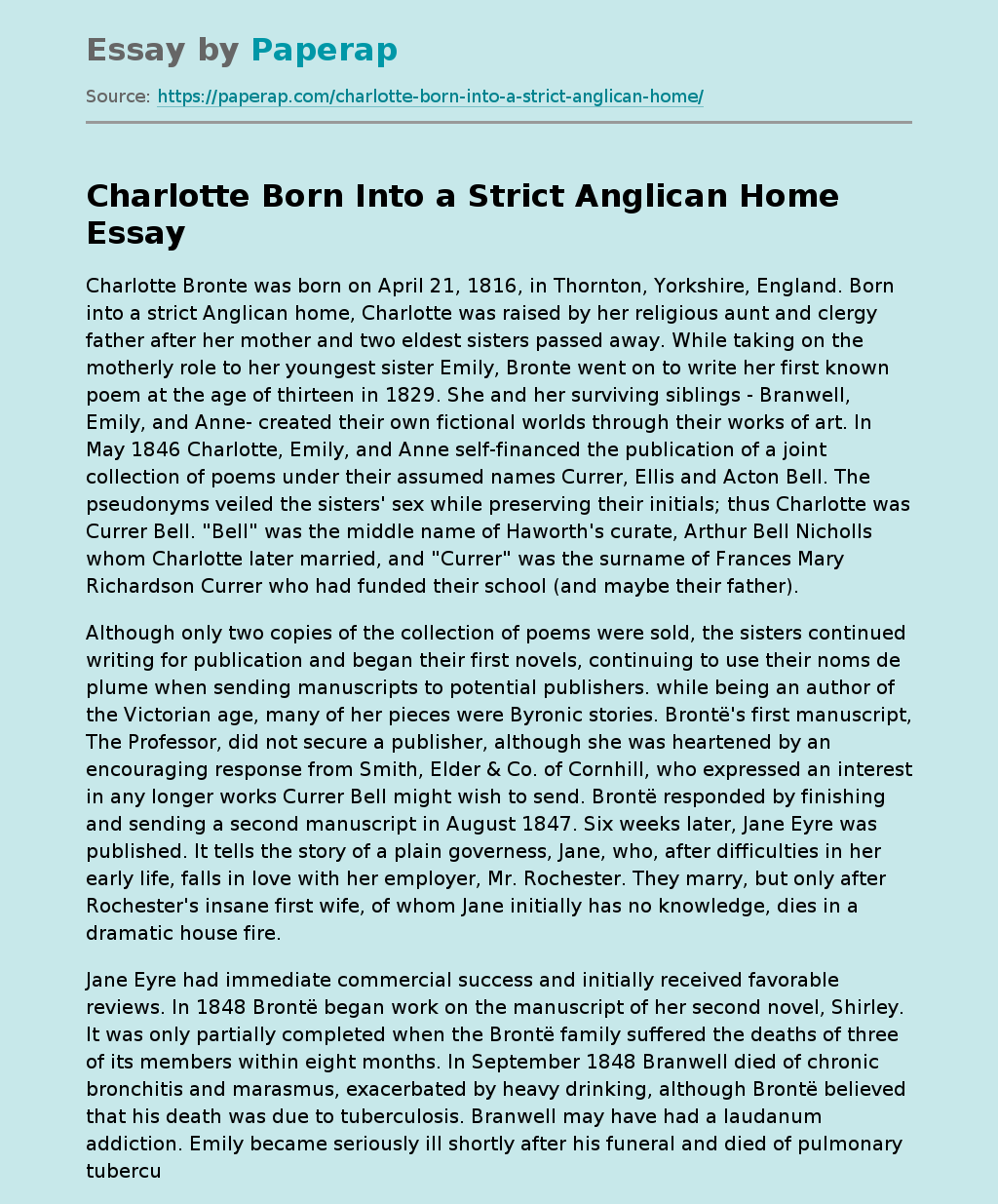Charlotte Bronte English Poet and Novelist
The following example essay is dedicated to Charlotte Brontë, an English poet and novelist. Read the introduction, body and conclusion of the essay, scroll down.
Charlotte Bronte was born on April 21, 1816, in Thornton, Yorkshire, England. Born into a strict Anglican home, Charlotte was raised by her religious aunt and clergy father after her mother and two eldest sisters passed away. While taking on the motherly role to her youngest sister Emily, Bronte went on to write her first known poem at the age of thirteen in 1829.
She and her surviving siblings – Branwell, Emily, and Anne- created their own fictional worlds through their works of art. In May 1846 Charlotte, Emily, and Anne self-financed the publication of a joint collection of poems under their assumed names Currer, Ellis and Acton Bell. The pseudonyms veiled the sisters’ sex while preserving their initials; thus Charlotte was Currer Bell. “Bell” was the middle name of Haworth’s curate, Arthur Bell Nicholls whom Charlotte later married, and “Currer” was the surname of Frances Mary Richardson Currer who had funded their school (and maybe their father).
Although only two copies of the collection of poems were sold, the sisters continued writing for publication and began their first novels, continuing to use their noms de plume when sending manuscripts to potential publishers. while being an author of the Victorian age, many of her pieces were Byronic stories. Brontë’s first manuscript, The Professor, did not secure a publisher, although she was heartened by an encouraging response from Smith, Elder & Co.
of Cornhill, who expressed an interest in any longer works Currer Bell might wish to send. Brontë responded by finishing and sending a second manuscript in August 1847. Six weeks later, Jane Eyre was published. It tells the story of a plain governess, Jane, who, after difficulties in her early life, falls in love with her employer, Mr. Rochester. They marry, but only after Rochester’s insane first wife, of whom Jane initially has no knowledge, dies in a dramatic house fire.
Jane Eyre had immediate commercial success and initially received favorable reviews. In 1848 Brontë began work on the manuscript of her second novel, Shirley. It was only partially completed when the Brontë family suffered the deaths of three of its members within eight months. In September 1848 Branwell died of chronic bronchitis and marasmus, exacerbated by heavy drinking, although Brontë believed that his death was due to tuberculosis. Branwell may have had a laudanum addiction. Emily became seriously ill shortly after his funeral and died of pulmonary tuberculosis in December 1848. Anne died of the same disease in May 1849. Brontë was unable to write at this time. Unlike Jane Eyre, which is written in the first person, Shirley is written in the third person and lacks the emotional immediacy of her first novel, and reviewers found it less shocking. Brontë, as her late sister’s heir, suppressed the republication of Anne’s second novel, The Tenant of Wildfell Hall, an action that had a deleterious effect on Anne’s popularity as a novelist and has remained controversial among the sisters’ biographers ever since.
In view of the success of her novels, particularly Jane Eyre, Brontë was persuaded by her publisher to make occasional visits to London, where she revealed her true identity and began to move in more exalted social circles, becoming friends with Harriet Martineau and Elizabeth Gaskell, and acquainted with William Makepeace Thackeray and G.H. Lewes. Brontë’s friendship with Elizabeth Gaskell, while not particularly close, was significant in that Gaskell wrote the first biography of Brontë after her death in 1855. Brontë became pregnant soon after her wedding in 1854 to Arthur Bell Nicholls, but her health declined rapidly and, according to Gaskell, she was attacked by “sensations of perpetual nausea and ever-recurring faintness”. She died, with her unborn child, on 31 March 1855, three weeks before her 39th birthday. Her death certificate gives the cause of death as tuberculosis, but biographers including Claire Harman and others suggest that she died from dehydration and malnourishment due to vomiting caused by severe morning sickness or hyperemesis gravidarum Charlotte Brontë was buried in the family vault in the Church of St Michael and All Angels at Haworth.
Charlotte Bronte English Poet and Novelist. (2021, Feb 22). Retrieved from https://paperap.com/charlotte-born-into-a-strict-anglican-home/

